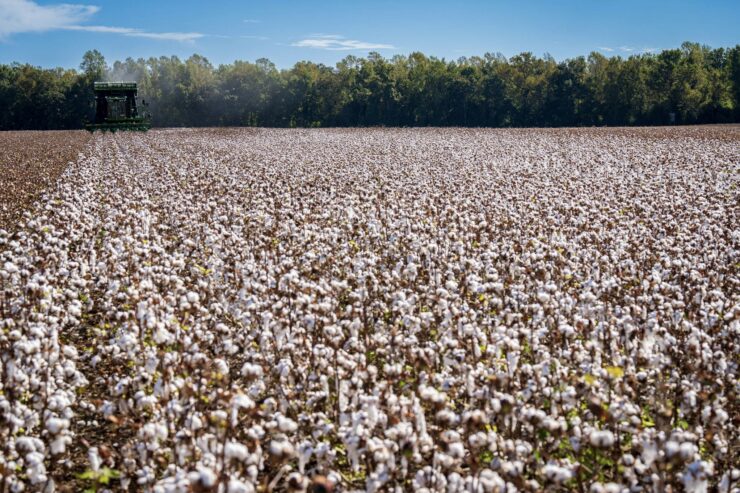
© DJI T30 drone in mission over cotton field
Xinjiang cotton drones are transforming agriculture in China’s largest cotton-growing region. In 2024, China’s total cotton output reached 6.164 million tonnes, up nearly 10 percent from the previous year, making it the second largest cotton producer worldwide. The majority of the nation’s cotton is grown in Xinjiang, which accounts for more than one fifth of global cotton production. The regional cotton and textile industries together generated an output value of about 220 billion yuan, equal to roughly 30 billion U.S. dollars. However, cotton farming in Xinjiang has faced ongoing challenges.
The region is dry and requires significant irrigation to sustain crops. Rising labor costs, combined with the remoteness of many farms, make it difficult to ensure timely planting, fertilization, and pest control. Traditional methods demand heavy manpower, and any delay in addressing pests or disease can result in serious crop loss.
To remain competitive and maintain its position in global markets, China has had to modernize its approach to cotton cultivation. Mechanization is now common in planting, and harvesting is nearly 90 percent mechanized. The next step has been the integration of digital tools and precision agriculture systems such as drones, which are redefining how crops are managed.
Xinjiang Cotton Drones at the Core of Farming

A recent report from China.org.cn titled “New Agricultural Practices in Xinjiang: More Smart Technologies, a Happier Life” highlights how China is setting a new standard in precision agriculture. In Xinjiang, drone technology has become a core part of cotton farming, enabling greater efficiency and significantly reducing the need for manual labor. Remote sensing drones are now widely used to patrol fields, monitor crop health, and identify early signs of pest or disease outbreaks. At the same time, agricultural spraying drones carry out automated pesticide applications with a level of precision that traditional methods cannot match.
“DJI Agriculture aims to boost farmland management efficiency by leveraging digital solutions and intelligent drones, all while prioritizing environmental sustainability,” – Yuan Zhang, Head of Global Sales at DJI Agriculture.
The scale of change is striking. In some cases, a super cotton field of about 494 acres can be managed by only two people, achieving yields above 3.34 tons per acre. More than 1,200 farms across Xinjiang have adopted this model, which now covers over 115,000 acres of cotton. In certain counties, drones are being used across more than 95 percent of fields. Farmers report that Xinjiang cotton drones save them about $2.05 per acre in costs, with spraying expenses reduced to roughly $1.10 per acre compared to about $2.75 per acre through manual or conventional methods. One farm couple now manages spraying for more than 115 acres in a single day using drones, a task that would have previously required a crew of 35 workers.
The DJI Agras Line Leading the Way
The most common drone system used in China’s agricultural industry is the DJI Agras. The Agras line has steadily expanded, offering models tailored to different farm sizes and operational needs. These drones come in a range of capacities suited to different agricultural demands. Some Agras models can carry a payload of more than 80 pounds and cover over 165 acres in a single day. The drones are equipped with specialized cameras and sensors, allowing for full automation and ease of use.
These systems now include AI-enabled remote sensing capabilities to monitor all aspects of crop health. In the long run, this not only reduces costs, time expenditure, and labor requirements but also supports greener, more sustainable farming practices.
A Global Shift in Farming Practices
In a 2023/2024 report released by DJI Agriculture, the company announced that China is far from being the only nation relying on DJI agricultural drones. The report indicates that despite regulatory hurdles, many countries, including the U.S., are implementing DJI drones for precision agriculture. “By the end of 2023,” DJI reported, “over 300,000 of these drones were in operation globally, having already treated more than 500 million hectares of farmland around the world.”
For farmers, the transformation is profound. With fewer workers required, costs are reduced and efficiency rises. Yields are more reliable, risks from pests and disease are contained earlier, and farmers gain time to focus on other aspects of their businesses. In Xinjiang, drone innovation is not only protecting one of the world’s most important cotton supplies but also creating a pathway toward a more sustainable and prosperous agricultural future. With the continued implementation of Xinjiang cotton drones, the region’s 2025 numbers are set to once again surpass expectations.
|